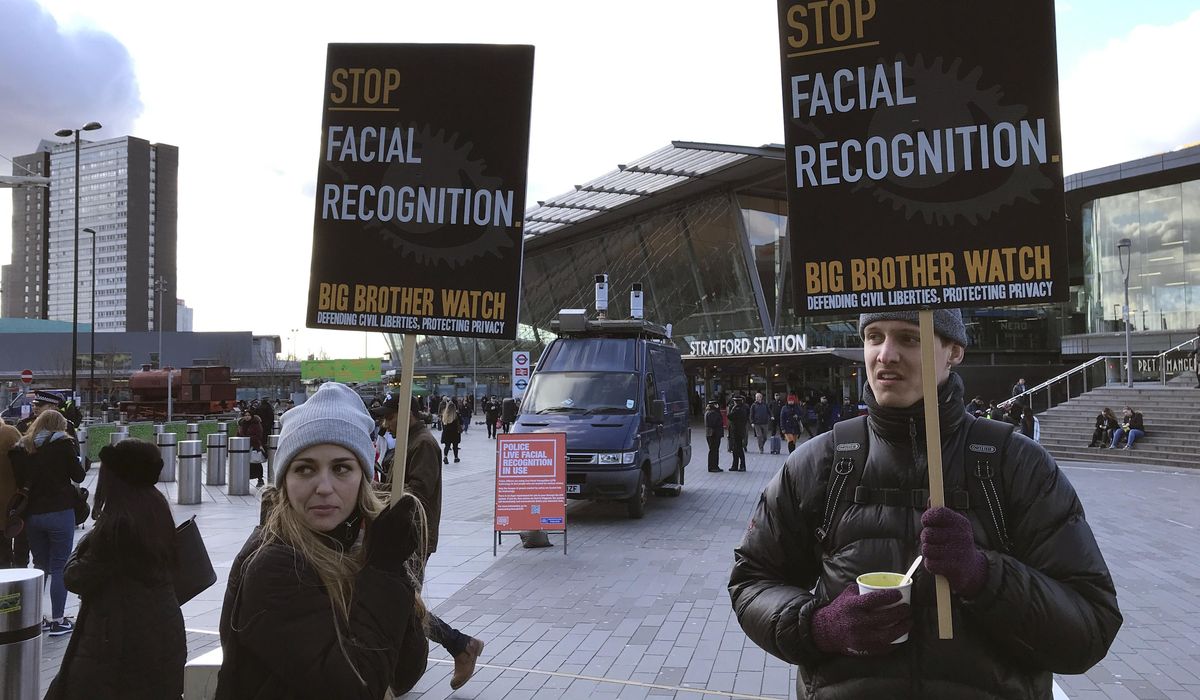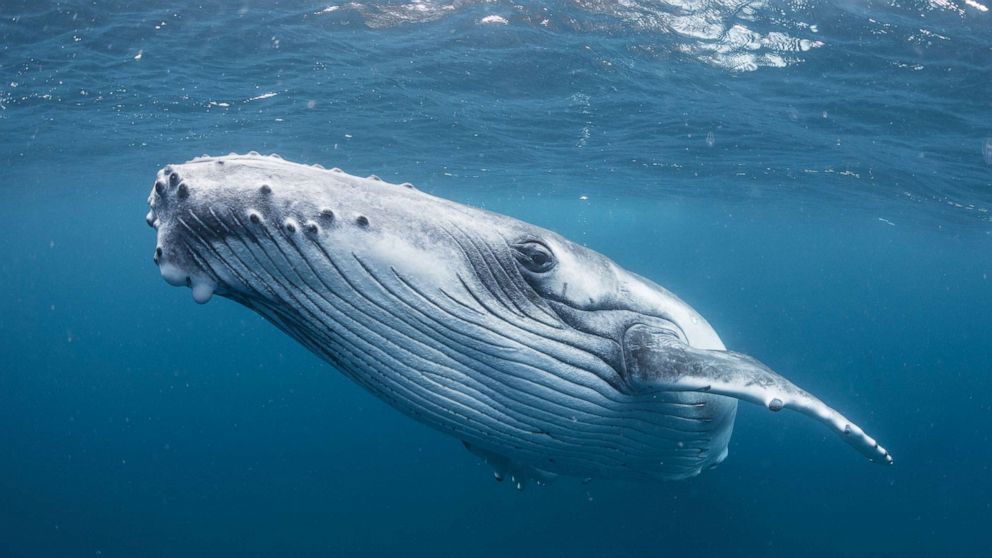Technology
With painted faces, artists fight facial recognition tech

[ad_1]
LONDON (AP) – As night falls in London, Georgina Rowlands and Anna Hart start applying makeup. Instead of lipstick and eyeliner, they’re covering their faces with geometric shapes.
Rowlands has long narrow blue triangles and thin white rectangles criss-crossing her face. Hart has a collection of red, orange and white angular shapes on hers.
They’re two of the four founders of the Dazzle Club, a group of artists set up last year to provoke discussion about the growing using of facial recognition technology.
The group holds monthly silent walks through different parts of London to raise awareness about the technology, which they say is being used for “rampant surveillance.” Other concerns include its lack of regulation, inaccuracy and how it affects public spaces.
Some 19 people attended the most recent event in the East London neighborhood of Shoreditch, and anyone can take part in the walks, in which participants have to paint their faces in a style called CV Dazzle.
The technique, developed by artist and researcher Adam Harvey, is aimed at camouflaging against facial detection systems, which turn images of faces into mathematical formulas that can be analyzed by algorithms. CV Dazzle – where CV is short for computer vision – uses cubist-inspired designs to thwart the computer, said Rowlands.
“You’re trying to kind of scramble that by applying these kind of random colors and patterns,” she said. “The most important is having light and dark colors. So we often go for blacks and whites, very contrasting colors, because you’re trying to mess with the shadows and highlights of your face.”
A similar technique was used extensively in World War I to camouflage British naval ships and confuse opponents about the actual heading or location of the ships.
To test that their designs work, they use the simple face detection feature on their smartphone cameras.
“I can see that I’m hidden, it’s not detecting me,” Rowlands said, checking her phone to see her face doesn’t have a square around it.
The rise of facial recognition technology is being tested and spreading in developed democracies after aggressive use in some more authoritarian countries like China.
Britain has long been used to surveillance cameras in public spaces to counter security threats, and London is ranked as having one of the world’s highest concentrations of closed-circuit television cameras. But that acceptance is being tested as authorities and corporations increasingly seek to deploy a new generation of cameras with facial recognition technology while activists, lawmakers and independent experts raise concerns about mass surveillance, privacy, and accuracy.
Opposition to algorithmic surveillance is not limited to Britain. Russia activists were reportedly arrested last month for holding a similar face paint protest over Moscow’s facial recognition cameras. Hong Kong pro-democracy activists routinely use face masks in street protests to hide their identities. Rights groups in Serbia and Uganda have opposed government projects to install Chinese-supplied cameras.
Other designers have come up with countermeasures like sunglasses that reflect infrared light to blind cameras.
“There is a movement of resistance against facial recognition that we are actively participating in and we want to kind of further initiate,” said Rowlands.
Rowlands, Hart and two other artists founded the Dazzle Club in August, following news that London’s King’s Cross district – a busy transport hub where many big offices are being built rapidly – had quietly experimented with live facial recognition cameras without public knowledge or consent, sparking a backlash.
London police recently started using live facial recognition cameras on operational deployments. Last week officers arrested a woman wanted for assault after the cameras picked her out of a street crowd on a busy shopping street. Police say new technology is needed to keep the public safe and images of innocent people are deleted immediately.
Public attitudes to facial recognition technology in Britain appear to be mixed, according to one survey last year, which found most people said they don’t know enough about it but nearly half said they should be able to opt out.
The Dazzle Club’s founders say they’re worried about the effect that the technology has on people in public if cameras are collecting their biometric data – facial images – without clearly explaining what’s being done with it.
“We’re having to adjust our behavior in public space in a way that I think is problematic,” said Hart.
___
Read more AP stories on developments in technology at https://apnews.com/apf-technology
[ad_2]
Source link
Technology
Apple unveils VR headset Vision Pro

[ad_1]

Apple unveiled its virtual reality (VR) headset, Vision Pro, Monday during its Worldwide Developers Conference.
Apple CEO Tim Cook called the headset a “new kind of computer” that augments reality by “seamlessly blending” the real world and the digital.
“It’s the first Apple product you look through and not at. Vision Pro feels familiar, yet it’s entirely new,” he said.
The product is controlled by the user’s eyes, hands and voice, Cook said.
Vision Pro will start at $3,499 and be available for purchase in early 2024.
Apple’s most direct competitor for Vision Pro appears to be Meta and its Quest headsets.
Meta, formerly known as Facebook, has put a greater focus on virtual reality and the so-called metaverse since the company changed its name in October 2021.
Last week, Meta announced its latest headset model, Quest 3, will be released later this year.
Copyright 2023 Nexstar Media Inc. All rights reserved. This material may not be published, broadcast, rewritten, or redistributed.
[ad_2]
Source link
Technology
Whales face more fatal ship collisions as waters warm

[ad_1]
PORTLAND, Maine —
Climate change is imperiling the world’s largest animals by increasing the likelihood of fatal collisions between whales and big ships that ply the same waters.
Warming ocean temperatures are causing some species of whales in pursuit of food to stray more frequently into shipping lanes, scientists say.
The phenomenon already has increased ship strikes involving rare North Atlantic right whales on the East Coast and giant blue whales on the West Coast, researchers say. The number of strikes off California increased threefold in 2018 — to at least 10 — compared to previous years.
When whales are killed in a ship collision, they often sink and don’t always wash ashore. So scientists and conservationists say fatal ship strikes are dramatically under-reported.
Vessels strikes are among the most frequent causes of accidental death in large whales, along with entanglement in fishing gear. Conservationists, scientists and animals lovers have pushed for the International Maritime Organization to step up to protect the whales, but it won’t happen without cooperation from the worldwide shipping industry.
For the right whales, which number only about 400 and have lost more than 10% of their population in just a few years, the death toll is driving them closer to extinction, said Nick Record, senior research scientist at Bigelow Laboratory for Ocean Sciences in East Boothbay, Maine.
At least three right whales died from ship strikes in 2019 — a small number, but still dangerously high for so small a population. All three deaths were documented in the Gulf of Saint Lawrence off Canada, where scientists have said the whales are spending more time feeding as waters off New England warm.
Scientists say the changing ocean environment with global warming is causing right whales and some other species to stray outside protected zones designed to keep them safe from ships.
“When one of their main food resources goes away, it means they start exploring new areas for food,” Record said. “And that means they’re encountering all new sources of mortality because they are going into these places where they are not protected.”
On the West Coast, where there was increase in whale ship strike deaths, scientists reported that the risk of such accidents has been growing in the 2000s as the blue whale population shifted northward in the North Pacific.
The increased ship strikes could necessitate “a broader area where ships don’t travel,” said Jessica Redfern, an ecologist with New England Aquarium’s Anderson Cabot Center for Ocean Life and lead author of a study published in the journal Frontiers in Marine Science in February.
Moving shipping lanes, and the possibility of enforcing slower speeds for large ships, is a subject of much debate among conservation groups, international regulators and the shipping industry.
Shippers say they have made attempts to work with conservationists, such as an ongoing effort to move a shipping lane in Sri Lankan waters to protect blue whales. In a statement to The Associated Press, the World Shipping Council expressed a willingness to keep working to keep shipping activity away from whales, but expressed skepticism about whether slowing vessels would help.
“Reduced ship speeds also increase the residence time of a ship in a given area where whales are active,” the council said. “Given those factors, there is some notable uncertainty about how effective reducing ship speeds is in lowering the risk of whale strikes.”
Changes to international shipping laws would have to go before the International Maritime Organization, which regulates shipping. The organization has taken numerous steps to protect whales in the past, including agreeing in 2014 to a recommendation for ships to reduce speed to 10 knots (11.5 miles per hour) off the Pacific coast of Panama for four months every summer and fall.
A spokeswoman for the organization declined to comment on the role of warming seas in increased ship strikes. But the subject has caught the attention of the National Oceanic and Atmospheric Administration, which oversees marine issues in the U.S.
Right whales, in particular, began showing a change in migratory behavior around 2010, said Vince Saba, a fisheries biologist with NOAA’s Northeast Fisheries Science Center. That happened as warm Gulf Stream water has entered the Gulf of Maine, a key habitat for the whales, he said.
“With that redistribution, the animals have moved into areas where there weren’t management rules in place to protect them. In a sense, the deck got reshuffled,” said Sean Hayes, head of the protected species branch for the fisheries science center.
Whales also face increased threat because ships now can travel in parts of the sea that were previously ice, said Regina Asmutis-Silvia, a scientist with Massachusetts-based Whale and Dolphin Conservation. As waters continue to warm, the whales will need more protections or the number of deaths will only grow, she said.
“The reality is that it’s time to actually implement the mitigation and that’s going to mean expanding areas where the speed rules would be in place,” she said.
———
Follow Patrick Whittle on Twitter: @pxwhittle
[ad_2]
Source link
Technology
Update to the latest Telegraph Android app

[ad_1]

We are no longer supporting this version of the The Telegraph app. You will need to update to our new app to continue accessing The Telegraph’s content. Please click here.
The new Telegraph app is available on Android 4.1.4 and later.
Our new, faster app delivers all of the content you love plus more:
-
A customisable menu so that you can select the news topics that matter to you.
-
A Top Stories channel highlighting our editor’s choice of the day’s key stories.
-
Notifications on the big news stories so you’re always in the know.
-
Beautiful design and simple usability, so you can scan the headlines at a glance and browse with complete ease.
Should you have any feedback or questions please visit our dedicated help site or email us at appfeedback@telegraph.co.uk.
[ad_2]
Source link
-

 Politics5 months ago
Politics5 months agoFEMA Staff Accused of Withholding Aid from Trump Supporters After Hurricane – Calls for Hate Crime Charges and Jail Time Emerge
-

 Entertainment5 months ago
Entertainment5 months agoGeorge Clooney’s Final Stand: Hollywood Icon QUITS Politics for Good After Kamala Harris’ Slip and Trump Triumph
-

 Politics1 year ago
Politics1 year agoTucker and President Trump explore Bedminster and talk about “America’s favorite sport” and what happens if you misbehave at Bedminster
-

 Politics5 months ago
Politics5 months agoPolish President Andrzej Duda Reportedly Visits Mar-a-Lago to Meet with Donald Trump
-

 Politics1 year ago
Politics1 year agoEXPOSED: JOE BIDEN TRAGEDY ADULT VIDEO PUBLISHED BY TUCKER!
-

 Politics5 months ago
Politics5 months agoTrump’s Bold Move: Dan Bongino for Secret Service Director? The Inside Scoop on Security and Threats!
-

 Politics5 months ago
Politics5 months agoFormer Disney and Pixar Designer Sentenced to 25 Years for Child Exploitation and Human Trafficking
-

 Politics5 months ago
Politics5 months agoTrump’s Bold Move: Appoints Hardline Border Czar to Launch Mass Deportations – “Kamala, You’re FIRED!
-

 Politics5 months ago
Politics5 months agoMSNBC in Flames! Pelosi Blames Biden for Kamala Endorsement—A Turning Point for the Democratic Party?






